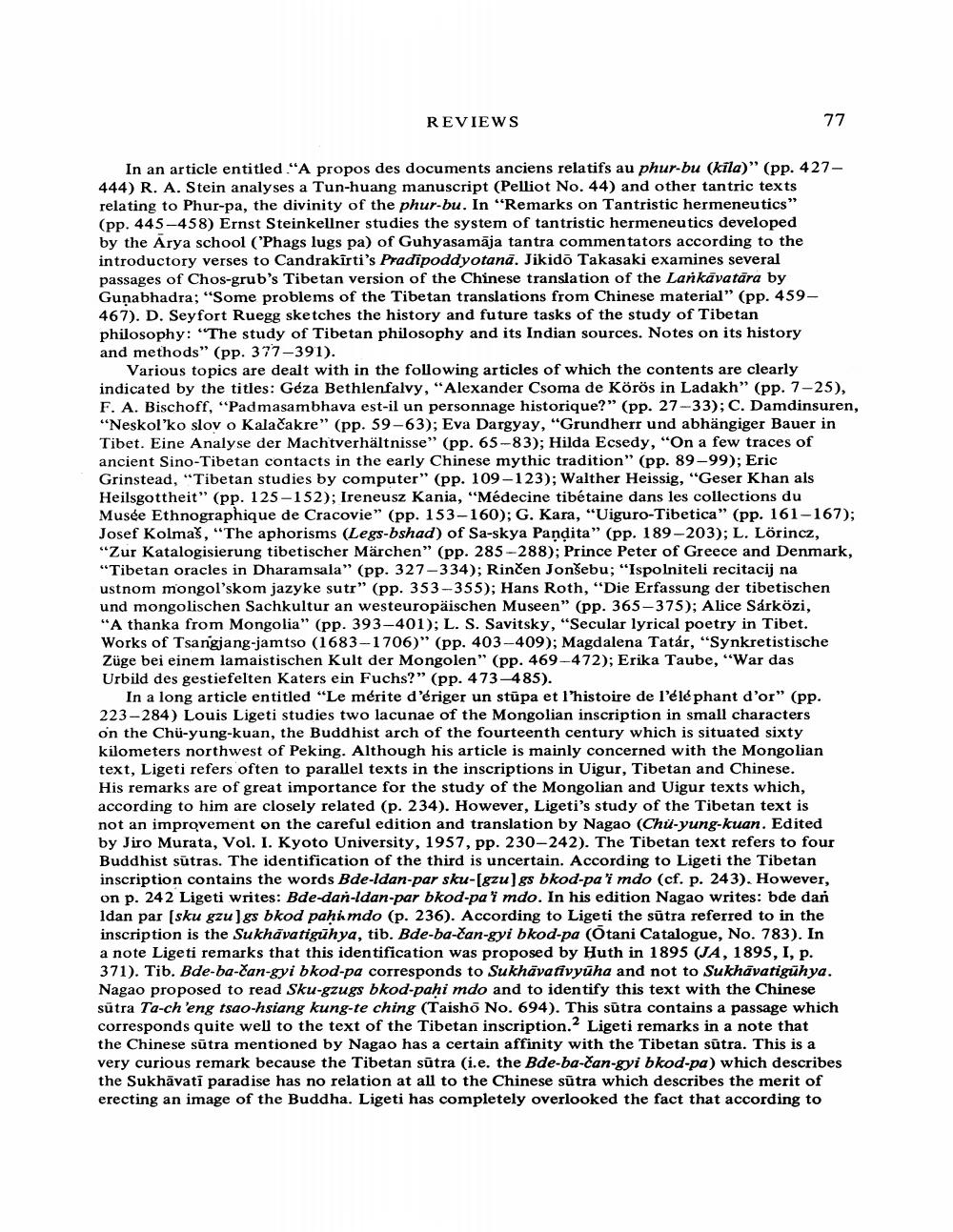Book Title: Book Reviews Author(s): J W De Jong Publisher: J W De Jong View full book textPage 7
________________ REVIEWS 77 In an article entitled "A propos des documents anciens relatifs au phur-bu (kīla)" (pp. 427444) R. A. Stein analyses a Tun-huang manuscript (Pelliot No. 44) and other tantric texts relating to Phur-pa, the divinity of the phur-bu. In "Remarks on Tantristic hermeneutics" (pp. 445-458) Ernst Steinkellner studies the system of tantristic hermeneutics developed by the Arya school ('Phags lugs pa) of Guhyasamāja tantra commentators according to the introductory verses to Candrakirti's Pradipoddyotanā. Jikidō Takasaki examines several passages of Chos-grub's Tibetan version of the Chinese translation of the Lankavatara by Guṇabhadra; "Some problems of the Tibetan translations from Chinese material" (pp. 459– 467). D. Seyfort Ruegg sketches the history and future tasks of the study of Tibetan philosophy: "The study of Tibetan philosophy and its Indian sources. Notes on its history and methods" (pp. 377-391). Various topics are dealt with in the following articles of which the contents are clearly indicated by the titles: Géza Bethlenfalvy, "Alexander Csoma de Körös in Ladakh" (pp. 7-25), F. A. Bischoff, "Padmasambhava est-il un personnage historique?" (pp. 27-33); C. Damdinsuren, "Neskol'ko slov o Kalačakre" (pp. 59-63); Eva Dargyay, "Grundherr und abhängiger Bauer in Tibet. Eine Analyse der Machtverhältnisse" (pp. 65-83); Hilda Ecsedy, "On a few traces of ancient Sino-Tibetan contacts in the early Chinese mythic tradition" (pp. 89-99); Eric Grinstead, "Tibetan studies by computer" (pp. 109-123); Walther Heissig, "Geser Khan als Heilsgottheit" (pp. 125-152); Ireneusz Kania, "Médecine tibétaine dans les collections du Musée Ethnographique de Cracovie" (pp. 153-160); G. Kara, "Uiguro-Tibetica" (pp. 161-167); Josef Kolmaš, "The aphorisms (Legs-bshad) of Sa-skya Pandita" (pp. 189-203); L. Lörincz, "Zur Katalogisierung tibetischer Märchen" (pp. 285-288); Prince Peter of Greece and Denmark, "Tibetan oracles in Dharamsala" (pp. 327-334); Rinčen Jonšebu; "Ispolniteli recitacij na ustnom mongol'skom jazyke sutr" (pp. 353-355); Hans Roth, "Die Erfassung der tibetischen und mongolischen Sachkultur an westeuropäischen Museen" (pp. 365-375); Alice Sárközi, "A thanka from Mongolia" (pp. 393-401); L. S. Savitsky, "Secular lyrical poetry in Tibet. Works of Tsangjang-jamtso (1683-1706)" (pp. 403-409); Magdalena Tatár, "Synkretistische Züge bei einem lamaistischen Kult der Mongolen" (pp. 469-472); Erika Taube, "War das Urbild des gestiefelten Katers ein Fuchs?" (pp. 473-485). In a long article entitled "Le mérite d'ériger un stūpa et l'histoire de l'éléphant d'or" (pp. 223-284) Louis Ligeti studies two lacunae of the Mongolian inscription in small characters on the Chu-yung-kuan, the Buddhist arch of the fourteenth century which is situated sixty kilometers northwest of Peking. Although his article is mainly concerned with the Mongolian text, Ligeti refers often to parallel texts in the inscriptions in Uigur, Tibetan and Chinese. His remarks are of great importance for the study of the Mongolian and Uigur texts which, according to him are closely related (p. 234). However, Ligeti's study of the Tibetan text is not an improvement on the careful edition and translation by Nagao (Chü-yung-kuan. Edited by Jiro Murata, Vol. I. Kyoto University, 1957, pp. 230-242). The Tibetan text refers to four Buddhist sutras. The identification of the third is uncertain. According to Ligeti the Tibetan inscription contains the words Bde-ldan-par sku-[gzu]gs bkod-pa'i mdo (cf. p. 243). However, on p. 242 Ligeti writes: Bde-dan-ldan-par bkod-pai mdo. In his edition Nagao writes: bde dan Idan par [sku gzu]gs bkod paḥimdo (p. 236). According to Ligeti the sutra referred to in the inscription is the Sukhavatiguhya, tib. Bde-ba-čan-gyi bkod-pa (Ōtani Catalogue, No. 783). In a note Ligeti remarks that this identification was proposed by Huth in 1895 (JA, 1895, I, p. 371). Tib. Bde-ba-čan-gyi bkod-pa corresponds to Sukhāvativyūha and not to Sukhāvatigūhya. Nagao proposed to read Sku-gzugs bkod-paḥi mdo and to identify this text with the Chinese sutra Ta-ch'eng tsao-hsiang kung-te ching (Taishō No. 694). This sūtra contains a passage which corresponds quite well to the text of the Tibetan inscription.2 Ligeti remarks in a note that the Chinese sutra mentioned by Nagao has a certain affinity with the Tibetan sutra. This is a very curious remark because the Tibetan sūtra (i.e. the Bde-ba-čan-gyi bkod-pa) which describes the Sukhāvati paradise has no relation at all to the Chinese sutra which describes the merit of erecting an image of the Buddha. Ligeti has completely overlooked the fact that according toPage Navigation
1 ... 5 6 7 8 9 10 11 12 13 14 15 16 17 18 19 20 21 22 23 24 25 26 27 28 29 30 31 32 33 34 35 36 37 38
